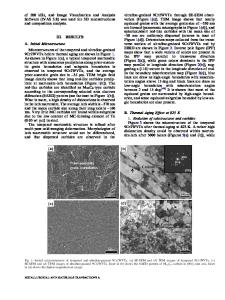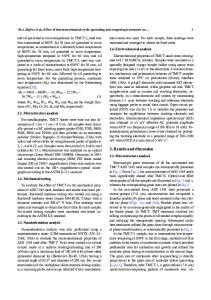Influence of Aging and Thermomechanical Treatments on the Mechanical Properties of a Nanocluster-Strengthened Ferritic S
- PDF / 1,750,868 Bytes
- 9 Pages / 593.972 x 792 pts Page_size
- 11 Downloads / 311 Views
ODUCTION
PRECIPITATION strengthening of steels by Cu-rich nanoscale precipitates is of great commercial importance because the low carbon content of these strong steels results in improved ductility and weldability.[1–3] The Cu additions can compensate for the decrease in strength from reducing the C concentration through precipitation of Cu-rich nanoclusters.[4,5] The low-carbon with copper-addition steels, such as high strength low-alloy (HSLA) steels, were initially developed by the U.S. Navy for use in the construction of the hulls of Z.W. ZHANG, Research Fellow, is with the Materials Research & Education Center, Auburn University, Auburn, AL 36849, and also a Lecturer, with the Engineering Research Center of Materials Behavior and Design, Ministry of Education, Nanjing University of Science and Technology, Nanjing 210094, P. R. China. C.T. LIU, Distinguished Professor, is with the Materials Research & Education Center, Auburn University, and also a Professor, with the MEEM Department, College of Science and Engineering, City University of Hong Kong, Kowloon, Hong Kong. Contact e-mail: [email protected] Y.R. WEN, Doctoral Student, A. HIRATA, Assistant Professor, and M.W. CHEN, Professor, are with the WPI Advanced Institute for Materials Research, Tohoku University, Sendai 980-8577, Japan. S. GUO, Research Fellow, formerly with the Department of Mechanical Engineering, the Hong Kong Polytechnic University, Kowloon, Hong Kong, is now with the MEEM Department, College of Science and Engineering, City University of Hong Kong. G. CHEN, Professor, is with the Engineering Research Center of Materials Behavior and Design, Ministry of Education, Nanjing University of Science and Technology. BRYAN A. CHIN, Professor, is with the Materials Research & Education Center, Auburn University. Manuscript submitted February 21, 2011. Article published online July 27, 2011 METALLURGICAL AND MATERIALS TRANSACTIONS A
ships and submarines.[6,7] Because of their high strength, good impact toughness, and excellent weldability, these steels are also of interest to the transportation, civil infrastructure, and defense industries for applications such as vehicle frames for heavy duty trucks, oil pipelines, offshore drilling platforms, bridges, military vehicles, etc.[3,8–12] Previous research on HSLA steel plates showed that the quenching, tempering and aging processes were needed to produce martensitic steels containing Cu precipitates. The combination of the strength and toughness of these steels was obtained by tempered lath martensite structures along with somewhat overaged Cu precipitates.[3,11–13] Recent research on Cu-rich nanocluster strengthened steels indicated that body-centered-cubic (bcc) Cu-rich nanoclusters are coherent with the steel matrix and provide significant precipitation strengthening. As a result, the processes of martensite formation and subsequent tempering are no longer required.[14–16] The strength of the Cu-rich nanocluster strengthened ferritic steels is derived mainly from nanocluster precipitation strengt
Data Loading...











